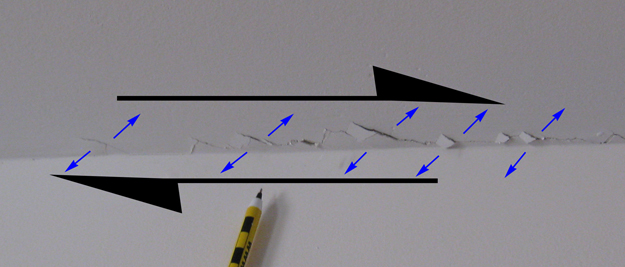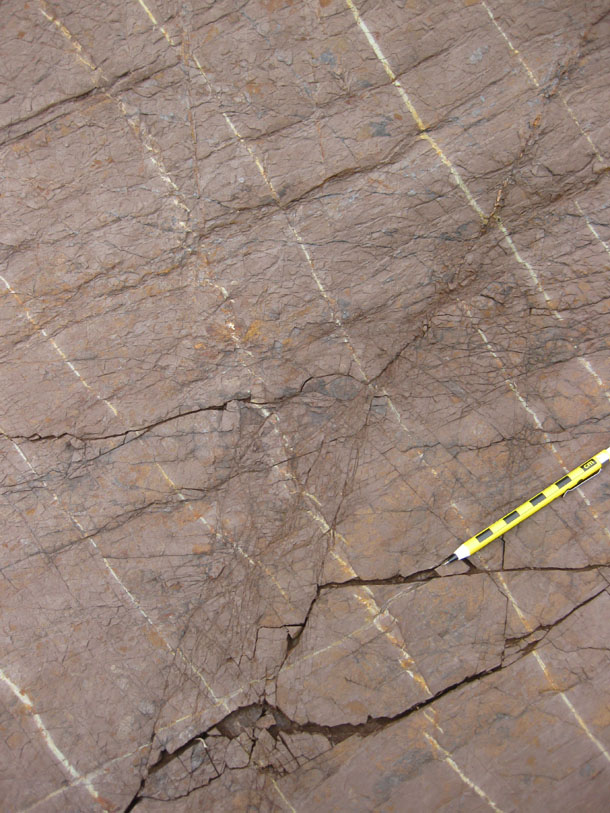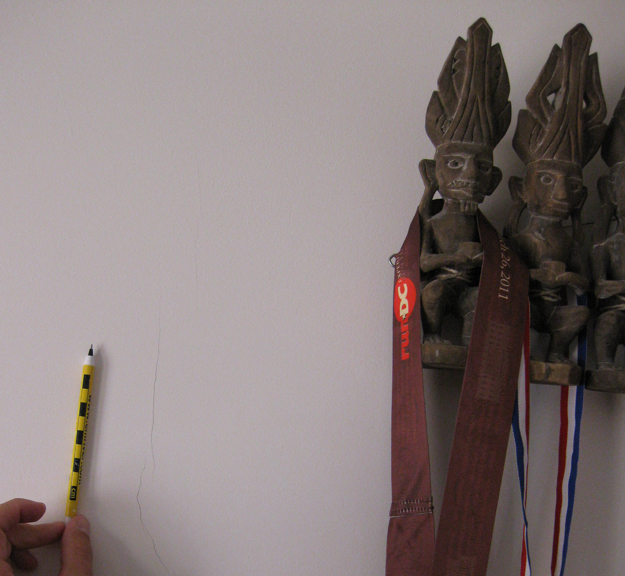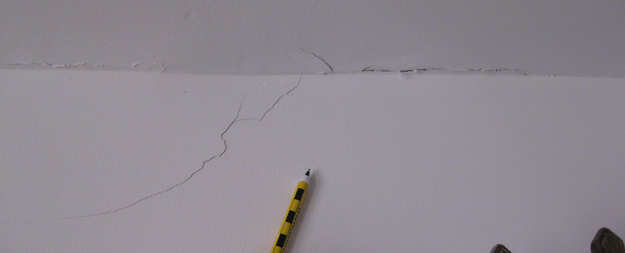24 August 2011
Cracking up
Posted by Callan Bentley
So here’s a brief discourse on some of the damage we incurred at my condominium yesterday…
Fracture in plaster wall, Iban figures, marathon medallions, and a cm-demarcated pencil for scale.
Fractures along wall/ceiling join, cm-demarcated pencil for scale.
Fractures along wall/ceiling join, cm-demarcated pencil for scale.
Any of those previous three images are enlarge-able by clicking on them.
These cracks are, of course, damage we sustained due to the magnitude 5.8 Mineral, Virginia earthquake.
This last one in particular catches my attention, because of the common orientation of all the small fractures, oriented at a ~30° angle to the seam between the wall and the ceiling. This pattern, called en echelon, forms when rocks (or homes) are sheared, and then fail in a brittle fashion. In the case of my condo, the ceiling was moving to the right at the moment of failure (west) and the wall was either standing still or was moving to the left (east). Either way, the stress on the painted seam between them was greater than the strength of the paint layer, and it fractured.

The fractures are oriented perpendicular to the maximum stretching direction (shown by the blue arrows). All are on the same order of magnitude in size, and all are roughly oriented in the same direction, as roughly the same stress field produced all of them. I’ve shown you this same sort of thing before in large areas like the Volcanic Tableland of California:

…Or when the fractures have been sealed with quartz veins, as in this example from the Antietam Formation sandstone of the Virginia Blue Ridge.

photo18
Another example, about the same size as the cracks in my ceiling, was featured in the “Geology of San Francisco” series I posted after AGU last year (with the same sense of scale!):

And then, of course, we mustn’t neglect the same feature forming in limestone:

En echelon tension fractures! Hopefully NOT coming soon to a home near you!
Okay, I’m done geeking out on the geological analogue that formed in my home yesterday afternoon.
Lastly, let me share an image of someone else’s damage. This is a photo from the home of the family of a colleague of mine, taken yesterday afternoon:

That’s a close call – unreinforced masonry is one of the biggest risks when it comes to quakes in areas where building codes leave people unprepared for events the size of yesterday’s.





 Callan Bentley is Associate Professor of Geology at Piedmont Virginia Community College in Charlottesville, Virginia. He is a Fellow of the Geological Society of America. For his work on this blog, the National Association of Geoscience Teachers recognized him with the James Shea Award. He has also won the Outstanding Faculty Award from the State Council on Higher Education in Virginia, and the Biggs Award for Excellence in Geoscience Teaching from the Geoscience Education Division of the Geological Society of America. In previous years, Callan served as a contributing editor at EARTH magazine, President of the Geological Society of Washington and President the Geo2YC division of NAGT.
Callan Bentley is Associate Professor of Geology at Piedmont Virginia Community College in Charlottesville, Virginia. He is a Fellow of the Geological Society of America. For his work on this blog, the National Association of Geoscience Teachers recognized him with the James Shea Award. He has also won the Outstanding Faculty Award from the State Council on Higher Education in Virginia, and the Biggs Award for Excellence in Geoscience Teaching from the Geoscience Education Division of the Geological Society of America. In previous years, Callan served as a contributing editor at EARTH magazine, President of the Geological Society of Washington and President the Geo2YC division of NAGT.
Thank you. Cindy was correct. I learned some new things and enjoyed this…almost as much as the quake itself.
Who’s Cindy?
[…] I indicated at the end of Wednesday’s post about damage to my condo, chimneys are a huge risk in earthquakes because they are (a) often constructed from unreinforced […]
[…] clearly separated along their mortared edges, and the disruption of the paint layer in a series of en echelon fractures reveals that deeper structural issue. I find this a bit […]
[…] final photo – a treat for the structural geologists out there. Here’s an en echelon series of rips in the mafic rock, hosting small granitic […]